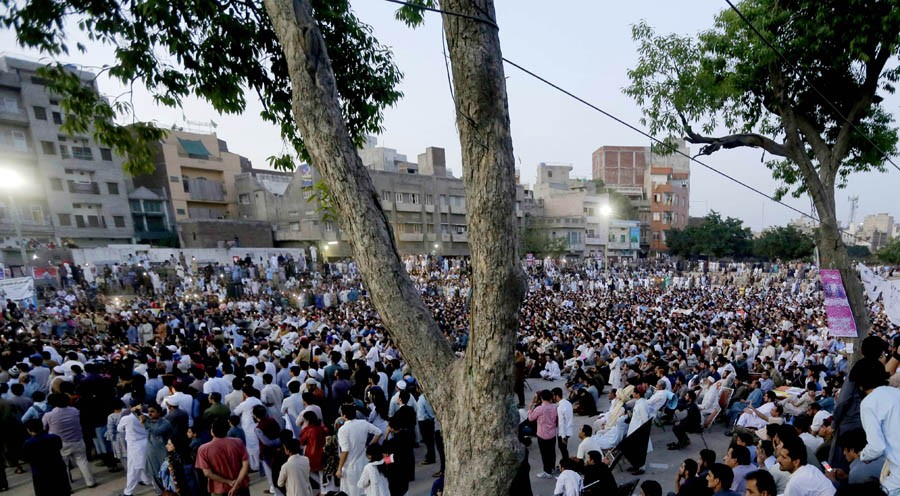
The historic Bagh in Mochi Darwaza has been a significant rallying point for leading political movements, since the Raj

Amidst fiery speeches and a charged crowd, Mukhtiyar Ahmed was perched high on the upper flight of stairs in complete silence. The 72 years old resident of the Walled City of Lahore was present at the famous bagh (garden), bairoon (outside) Mochi Darwaza, not to attend the political rally that was taking place at the time but to soak in the humbling ambience of the place.
With his back to the tall, residential compounds, the old man witnessed the spectacle of a public protest unfold in front of him. "Lahore is abuzz today," he said to the person sitting next to him. His excitement gleamed through his tired, rheumy eyes. "It’s good to see my Lahore waking up to the broad political culture it once had."
An entire history of political activism and involvement beyond the ballot defines this 16th-century place, which was built by Emperor Akbar. From Nasir Bagh on the Mall to Minto Park (now Greater Iqbal Park), the city boasts a political culture that has provided a platform for dissenting voices and popular agitations. The empty space behind Mochi Gate which, as historian Majid Sheikh notes, "housed the Mughal cavalry units, mostly of Turkish origin," carved an important niche for itself as the rallying point for famous political movements in years to come.
The transition of Mochi Bagh, as it came to be known as, from being a morcha (picket) on the south-eastern side of the Walled City during Akbar’s reign, to a place for holding political discourse, has seen empires fall apart. The dusty, dry patch, also called "Mochi jalsa gah," has had the unique privilege of hosting public gatherings against state oppression. In short, the air around it has always been filled with slogans of resistance. This distinct political identity naturally feeds the impression, among progressive admirers and conservative critics alike, of Mochi Gate being a realm apart.
The Bagh rose to prominence when great men like Mahatma Gandhi, Mohammad Ali Jinnah, Jawaharlal Nehru, Abul Kalam Azad, and Liaquat Ali Khan fanned the embers of civil rights, which later translated into the wish for complete independence, by baring the naked economic and strategic interests which prompted nearly all the moves of the imperial powers in the region.
It was around this time that Mochi Bagh also witnessed the rise of Ustad Daman, one of the most celebrated Punjabi poets of the 20th century, when he was invited to recite his revolutionary poetry at a Congress National Party public gathering in the 1930s, in which Nehru declared him the "Poet of Freedom."
Be it well-planned strategic action or highly charged, impromptu political rallies, Mochi Bagh has always absorbed the willingness of activists in support of the ideals of freedom and equality. For the decades that followed, independence speakers like Khan Abdul Ghaffar Khan, Hussain Shaheed Suhrawardy, and Nawabzada Nasrullah Khan kept intact its jalsa gah stature, providing space to people who dared to challenge authoritarian regimes.
But it was popular political leaders like Zulfikar Ali Bhutto and Wali Khan, and revolutionaries such as Habib Jalib who revived the glorious past of the place. Bhutto’s fiery speeches against Ayub Khan’s military dictatorship made Mochi Bagh the choicest venue for his freshly Pakistan People’s Party’s jiyalas to hold public meetings. During Zia’s reign of terror, Jalib’s recitation of ‘Dastoor’ at the Bagh, and the mesmerised crowd shouting, "Mein nahin manta, mein nahin janta" along with him, opened up the mind’s eye to the time when Ustad Daman would stir emotions of a sea of people with his anti-imperialistic verses.
The recently held public gathering of Pashtun Tahfuz Movement (PTM) at the historic venue was an indication to the long held beliefs that any movement in Pakistan is incomplete without a gathering at Mochi Gate. As the demonstrators from all over the country, many of them youth, began to protest against the injustices being done to the Pashtuns, especially in the federally administered tribal areas (Fata), others questioned the value, the strategy, and the timing of the protest in Lahore. The time for activism, critics said, was not right.
A similar indication was given by the PTM central leader Ali Wazir when he said during his speech that the movement had come to Lahore so that "if something happens in the future, nobody can say we did not reach out to them."
Back at the jalsa gah, Mukhtiyar Ahmed joined the crowd chanting the slogan, "Inquilab zindabad!" He was reliving every moment of the rich history of the place -- for marches, rallies, and political activism are what have given Mochi Gate its distinct identity.